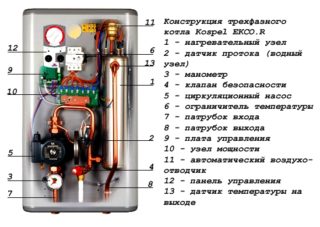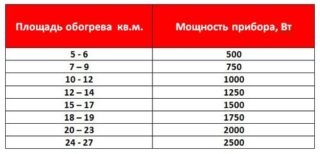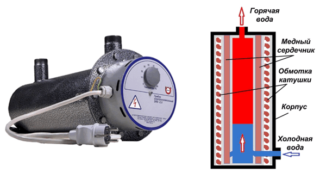When designing heating, they pay attention to the availability of energy sources, the cost of equipment and the cost of connecting to power grids, operating costs. In some cases, the owner is forced to heat with electricity. Which electric boilers are better for a private house is better, you should find out in advance, even before going to the store. Units vary in characteristics and design. Only a comprehensive assessment will help make the right choice.
Features of electric boilers
When deciding which electric boiler to choose for a particular house, several factors are taken into account.
For gas equipment, a technological connection will cost a fixed amount of about 50 thousand rubles. But this is if the highway passes along the street. In other cases, the amount reaches 1 million. Additionally, it is worth considering the cost of the project.
For the installation of an electric heating boiler, no coordination is required, just the electricity networks that are already entered into the house. The cost of a new connection by law does not exceed 1000 rubles.
The restriction imposes only the allowed power. The issue is resolved with the supplying organization.
Advantages and disadvantages
Electric boilers have positive and negative properties that must be taken into account.
The advantages include:
- electrical and fire safety in the case of installing differential machines or residual current devices;
- low cost;
- high, up to 95%, efficiency;
- the possibility of self-installation;
- noiselessness (not for all types);
- convenience of adjustment and control, including the option of remote switching on and setting the temperature in the "smart home" system;
- a wide selection of power, design, functionality.
The disadvantages are associated with high costs for paying for electricity during round-the-clock operation, inoperability during power outages. At the initial installation, it will be necessary to upgrade the power supply to the state in which it will withstand the maximum power of the equipment.
General principles of construction
The design of electric boilers of any type is made according to the general scheme and consists of structural components that are identical in purpose.
The device contains:
- a heating element;
- heat exchanger;
- control and protection devices;
- housing;
- fittings for connecting to utility networks.
The principle of operation is simple: a heating element installed in the heat exchanger, under the influence of an electric current, brings water or antifreeze to a predetermined temperature. The circulation pump creates the movement of the coolant through the pipes and radiators of the heating system. Hot water is cooled in the batteries and returned to the boiler.
The process is then repeated. All types of boilers work on this principle.
Electric double-circuit boilers for heating and water supply, in addition to the coolant, heat water for household needs (washing, shower). The contours are completely separated.
For heating, you can use antifreeze, it does not mix with water for food and hygiene purposes.
Options for selection
The power of the equipment is selected according to the size and energy efficiency of the house. A boiler of insufficient capacity is not able to warm the structure to an acceptable temperature for life.
The boiler is chosen with a margin of 10 - 15% of the maximum power required for heating. This is useful on particularly frosty days.At the same time, equipment operating at the limit of capabilities serves significantly less.
Boilers designed for 220 V are able to heat a room with a maximum of 80 m2, subject to high-quality insulation of building structures.
The effect is exerted by the remoteness of housing from the distribution substation, preferably no more than 2-3 km.
Houses over 80 m2 are heated with three-phase units of 380 V. The models on the market can heat a house with a maximum area of 400 m2. If the building is larger, install two or more boilers.
An important point is the appearance of the device and the installation method. Boilers are produced for installation on the floor and for wall placement, which must be taken into account when designing heating pipelines. Models with unusual design solutions are more expensive than analogues in classic cases. If the boiler room is in an enclosed space, choose models without frills.
The price of equipment depends on quality and brand. It is worth reading user reviews on forums and social networks about the model you like. Often, products from a well-known manufacturer are unreasonably expensive. After analyzing the information received, select an affordable financial unit.
The method of heating the coolant
The type of heating element directly affects the consumer properties of the boiler. Manufacturers use three types of electric heaters:
- tubular;
- electrode;
- varieties of induction.
Efficiency of all structures is in the range of 90 - 95%, but there are operating features.
TENY
Tubular electric heaters (heating elements) are used in boilers of low and medium power.
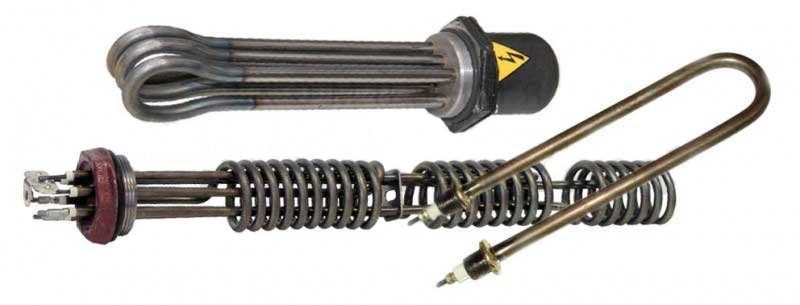
Inside the tube of steel or titanium alloy is a spiral of nichrome with high resistivity. When passing through a spiral of electric current, it heats up, gives off heat to the tube, which heats the coolant.
Heating elements are inexpensive, standardized for seats or threads on the body.
Replacing a failed heater is easily and quickly carried out on its own.
The design drawback is a large thermal inertia, until the temperature of the Ten itself goes into operation, it takes 10 - 15 minutes, the process of heating water is slow. Using boilers with such heaters is more profitable during round-the-clock operation. In the country, you have to wait a long time for the rooms to warm up.
When buying equipment, they immediately purchase a spare heater, so that in case of breakdown, you do not have to look for a replacement for a long time.
The disadvantage of this type of heaters is the formation of scale on the walls of the tube. The scale does not allow heat to pass through well, the walls do not cool sufficiently and quickly burn out.
Several methods of protection against scale have been patented. The most common and affordable is the installation of heating elements with a protective anode.
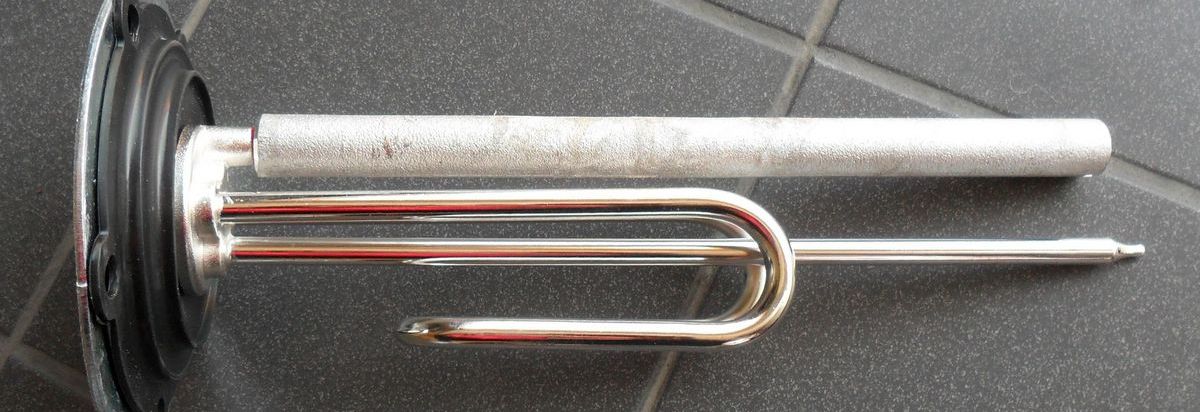
The anode is a replaceable part. The principle of operation is based on the fact that the part is gradually destroyed by ions, the scale does not settle on the heater, but precipitates.
Other methods that use the magnetic field that the heating coil creates are still not very common in boilers that are affordable.
An important drawback is the loss of power while reducing the supply voltage. This is taken into account in places remote from the transformer substation and in summer cottages with worn-out power lines.
Electrode
Ion-exchange or electrode boilers quickly became widespread in households.
The principle of operation is the flow of electric current between two electrodes.
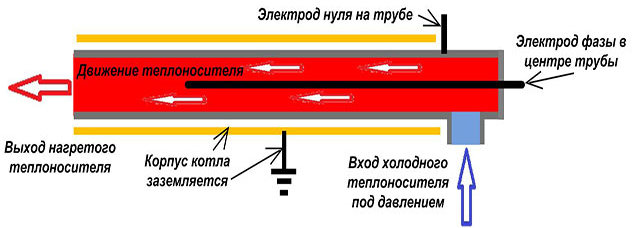
The geometric dimensions depend on the number of supply phases and power consumption.
The advantages include:
- low prices for spare electrodes;
- long service life in comparison with TENami;
- in the absence of water, the heater will turn off automatically, as the current will cease to flow between the electrodes;
- immediate start of electrolyte heating after switching on;
- high power.
For efficient operation, only a special electrolyte can be a heat carrier. Adding salt to the water gives a temporary effect, but serves as a pretext for the seller and the manufacturer to refuse the warranty.
Induction
In everyday life, induction boilers began to be used in the early 2000s.
Heating is due to electromagnetic induction. Alternating voltage is applied to the coil, which creates an electromagnetic field. It, in turn, heats the core.
The heated core warms the coolant.
Heating water to large values occurs faster than other types. There is no scale in the devices, so any liquid can be a coolant, even from a main water supply.
The disadvantage is the complexity of the design and special equipment for supplying high-frequency alternating voltage to the heater. Self-repair is not possible or is available only to trained users.
The vortex type is one of the varieties of induction heaters. The work is due to high frequency currents.
During operation, induction and vortex heaters emit noise. Such equipment is installed only in specially designated rooms. Feature applies to low-cost products.
The disadvantage of induction and vortex models is the high price.
Top manufacturers
In the market of electric boilers there are more than a dozen manufacturers. Distribution networks give preference to brands whose products are less likely to fail, and warranty obligations are fully implemented.
The table contains factories whose products are popular.
| The brand | Country | Boiler power range, kW |
| Protherm, SKAT Series | Czech Republic | 5–28 |
| Buderus, Robert Bosch GmbH | Germany | 20–60 |
| Kospel | Poland | 4–36 |
| Vaillant | Factory in Slovakia, owner of Proterm | 5–28 |
| Bosch | Germany | 4–24 |
| RusNIT | Russia | 3–100 |
| Evan | Russia | 2,5–400 |
| Ferroli | Italy | 6–28 |
| Ariston | Italy | 2,5–24 |
Automation in the products of the manufacturers presented is of high quality, spare heating elements are relatively inexpensive.
Each of the brands in Russia has a network of authorized service centers, so warranty and post-warranty repairs are not associated with great difficulties.
Buyer Memo
Based on the project of the house, the quality of insulation and the planned version of the heating system, they specify:
- the necessary boiler power sufficient to heat the house with a margin of 10-15%;
- purpose - heating or heating plus hot water supply (DHW);
- allowed connection capacity in the household and type of power supply (1 or 3 phases);
- the condition of the wiring and entry into the house, if necessary, the purchase of differential circuit breakers;
- type of installation - wall or floor;
- the desired type of heater, taking into account power and noise;
- the presence of an integrated control system, the need to purchase any external components.
Do not pay attention to the advertising promises of manufacturers about the increased efficiency of devices - boilers of any type translate into heat up to 95% of electricity consumed.
Electric boilers are affordable, easy to install and maintain, and easily withstand the operating life declared by the manufacturer. By choosing the right equipment and following the installation and operating instructions, the user receives a reliable heating device.

